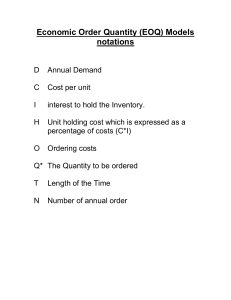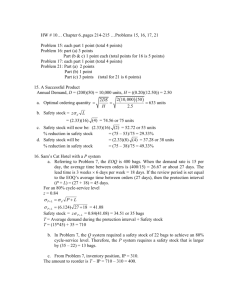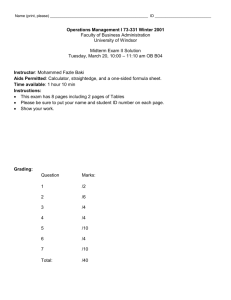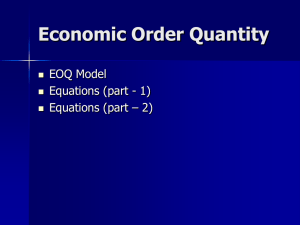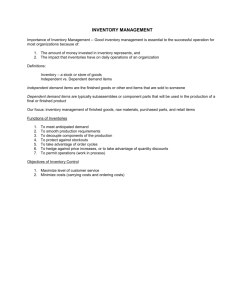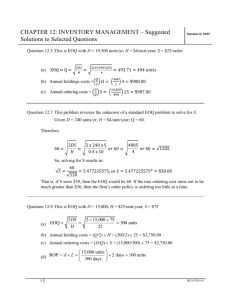Economic Order Quantity Holding or Carrying Cost Inventory Costs
advertisement
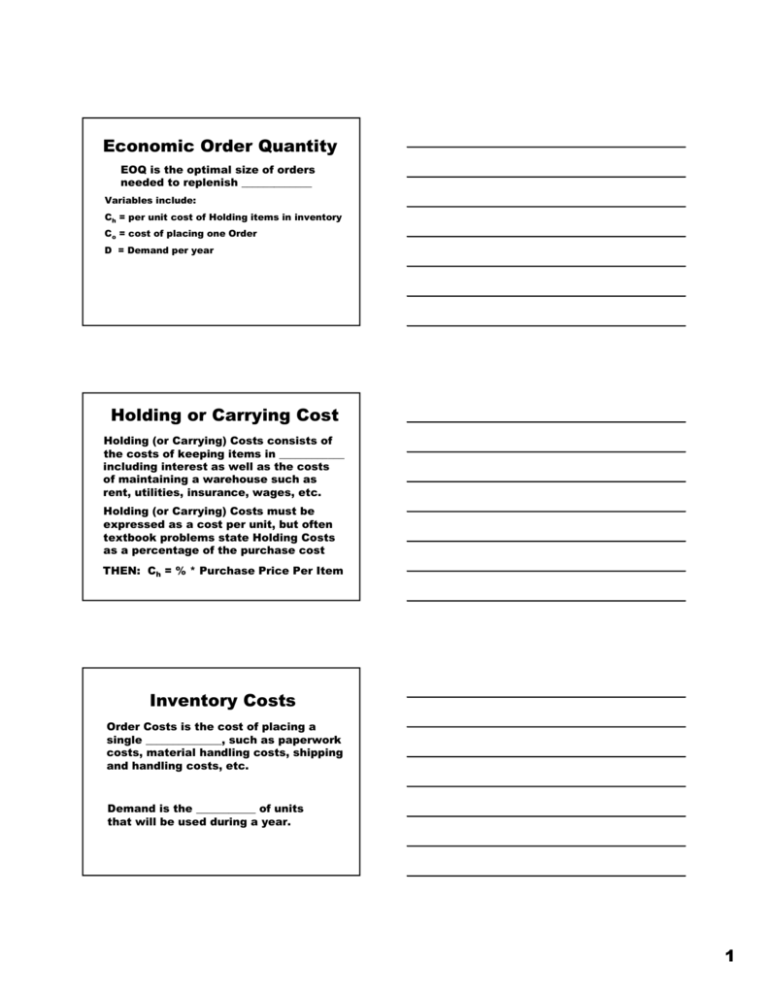
Economic Order Quantity EOQ is the optimal size of orders needed to replenish _____________ Variables include: Ch = per unit cost of Holding items in inventory Co = cost of placing one Order D = Demand per year Holding or Carrying Cost Holding (or Carrying) Costs consists of the costs of keeping items in ____________ including interest as well as the costs of maintaining a warehouse such as rent, utilities, insurance, wages, etc. Holding (or Carrying) Costs must be expressed as a cost per unit, but often textbook problems state Holding Costs as a percentage of the purchase cost THEN: Ch = % * Purchase Price Per Item Inventory Costs Order Costs is the cost of placing a single ______________, such as paperwork costs, material handling costs, shipping and handling costs, etc. Demand is the ___________ of units that will be used during a year. 1 Annual Holding Cost Assume that new ________ arrive just as the inventory runs out Lowest level of inventory will be zero just before the order is delivered Highest level of inventory will be the order quantity immediately after the order arrives The average number of units in inventory = (zero + order quantity) ÷ two annual holding costs = Ch * (Q+0)÷2 any number + zero = just the number annual holding costs = Ch * Q÷2 Annual Ordering Cost Number of orders placed will equal the demand divided by the ______ of the orders Number of Orders = D ÷ Q Annual Ordering Costs = C0 *(D ÷ Q) Annual Holding Cost Cost When the size of each order increases then more items must be kept in ____________ Total Annual Holding Costs will increase Order Quantity 2 Annual Order Cost Cost When the size of each order increases then the number of orders decrease So the Total Order Costs will decrease with _________ quantities Order Quantity Inventory Costs Cost Total Inventory Cost equals Annual Holding Costs plus Annual Ordering __________ Lowest Total Inventory Costs is where the two lines cross Holding Costs Order Costs Order Quantity Least Annual Inventory Costs Annual Ordering Costs = C0 * D÷Q Annual Holding Costs = Ch * Q÷2 Lines cross when the two ___________ equal each other Ch * Q÷2 = C0 * D÷Q 3 EOQ is where the two costs are equal (solve for Q) Annual Holding Costs = Annual Order __________ Ch cancels out Ch * Q Ch * 2 = C0 * D Q * Ch Divide both sides by Ch 2 cancels out 2* Q = Co * D *2 2 Q * Ch Multiply both sides by 2 Q * Q = 2 * Co * D * Q Q cancels out Q * Ch Multiply both sides by Q Q2 = 2 * Co * D ÷ Ch Then take the Square _______ of both sides of the equation Q2 = 2 * Co * D ÷ Ch Square root of Q2 = Q Q = 2 * Co * D ÷ Ch Q = Economic Order Quantity Example Demand equals 10,000 units per year Annual Holding Costs equals $2 per unit Order ________ equals $100 per order √ 2 * D * C0 ÷ Ch = Q √ 2 * 10,000 * 100 ÷ 2 = Q √ 1,000,000 = Q 1,000 = Q 4 Annual Inventory _________ EOQ = 1,000 units Average Inventory = (0 + EOQ) ÷ 2 Average Inventory = (0 + 1,000) ÷ 2 Annual Holding Costs = Avg Inv * Ch Annual Holding Costs = 500 * $2 per unit Annual Holding Costs = $1,000 Annual number of orders = Demand ÷ EOQ Annual Order Costs = # of orders * Order Cost Annual Order Costs = 10,000÷1,000 * $100 Annual Order Costs = $1,000 Annual Inventory _________ EOQ = 1,000 units Annual Holding Costs = $1,000 Annual Order Costs = $1,000 Annual Holding Costs = Annual Order Costs Economic Order Quantity EOQ is the optimal size for ___________ EOQ = √ 2 * D * C0 ÷ Ch Average Inventory = EOQ ÷ 2 Annual Holding Costs = Avg Inv * Unit Holding Cost Annual number of orders = Demand ÷ EOQ Annual Ordering Costs = # of Orders * Order Costs Total Annual Inventory Costs = Annual Holding Costs plus Annual Order Costs 5


